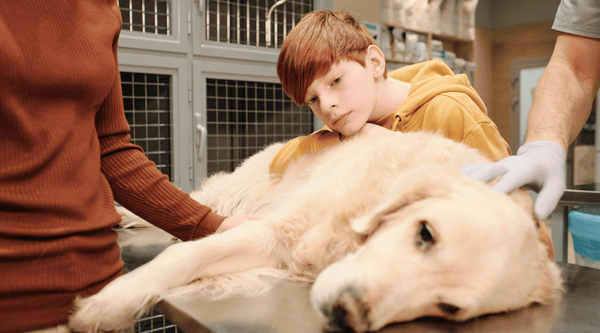We love our dogs for their speed around the dog park, but when it comes to mealtime, there are plenty of good reasons why they should eat slowly. Our furry friends may be at risk if they inhale their food in a blink of an eye.
Almost all of us nowadays are aware of the dangers of speed eating. Too often, dogs who eat too fast end up in the veterinarian's office. The cause of this is usually gastric dilatation-volvulus (GDV), more commonly known as bloat.
There is a lot more severity to it than typical indigestion. Bloat occurs when excess air, fluid, and food fill the dog's stomach due to inhaling their meal. In severe cases, the stomach can become so distended that the stomach twists, trapping gas inside and restricting blood flow to the organs. This can cause a dog to go into shock and die quickly.
Symptoms of bloat:
- Restlessness and pacing
- Abdominal pain
- Swelling of the stomach or abdominal wall
- Drooling
- Panting excessively
- Tiredness/ exhaustion
The importance of learning how to prevent dog bloat cannot be overstated since it is such a scary and potentially deadly condition and all the stress that comes with it.
Factors that contribute to gastric dilatation-volvulus GDV

Giant breeds and large breed dogs with deep chests, such as Akitas, Irish Setters, Irish Wolfhounds, St. Bernards, Boxers, Basset hounds, Great Danes, German Shepherds, and Weimaraners, are found to be more susceptible to bloating than small dogs.
Bloat still occurs relatively frequently despite greater awareness of its causes. This life-threatening condition means 25 per cent to 40 per cent of dogs do not survive GDV, even with emergency surgery.
Many dog owners opt for gastropexy surgery to reduce the severity of bloating in giant and large breed dogs. It is often done simultaneously as spaying or neutering the dog.
To prevent bloat, dog owners should take preventative measures when feeding their dogs. This is where slow-feeding dog bowls shine.
Is a Slow Feeder Dog Bowl safer than a Regular Dog Bowl?
We need to remember that our furry friends once roamed the wild and were not guaranteed a daily meal. Due to this, their eating habits evolved so that they could digest small amounts of food at a time.
A dog has eaten this way for centuries. Nowadays, house-bound dogs, who we love to smother in affection, face different challenges. Several digestive and health problems have been linked to large amounts of available food.
Dogs naturally eat food when they scavenge, hunt, and extract their meals from slow-feeder dog bowls instead of regular bowls. Eating slowly is safer.
Slow feeding dog bowls are designed to prolong feeding times, and these slow feeders reduce the risk of bloat, regurgitation, and canine obesity in dogs. You can feed your dog with peace of mind when it's time to eat.
Maintain the health and happiness of your furry friends by preventing dog bloat. Ideally, we should be able to give our dogs the freedom they want while keeping them healthy. Playing with their food allows dogs to eat a natural, healthy, and fun meal.
The benefits of a slow-feed dog bowl
The benefits of slow eating using a slow feeder dog bowl are numerous: your dog will be less likely to overeat since they'll have to work harder to get their food, thus promoting slower eating. They'll also get mental stimulation from figuring out how to get their meal out of the anti-gulp bowl, improving problem-solving skills and reducing boredom and frustration. Having dogs work for their food is more natural than simply munching down on cups of kibble or wet food.
In addition to providing physical benefits, slow-feed bowls provide mental stimulation through the challenges they present to your dog.
If your dog is used to eating from a normal or ceramic dog bowl, it may take some time to adapt to the feeder, so you must introduce it gradually and reward your dog for taking its time.
Conclusion
A slow feed bowl or puzzle feeder bowl comes in plastic, ceramic, or stainless steel bowls with a non-skid base. Different kinds of slow feeder dog bowls are available with challenges like mazes or puzzles that are dog-friendly. These bowls range in price from $8 to $40 online. Slow feeder bowls are best at teaching your dog to eat slowly so that he won't gulp down his bowl of food in less than a minute. You can encourage positive mental stimulation by slow feeding your dog, reducing gorging, and helping him lose weight.
We think slow-feed dog bowls are worth the money to keep your dogs healthy at mealtime, but make sure you select the correct slow-feed bowl for your dog. Slow feed bowls offer a variety of benefits over regular bowls at an affordable price.
Marley Slowappy Slow Feeder Dog Bowl
While your furry friend no longer needs to fight for food, those survival instincts can still persist even with the best-trained pup. That's why at Super Feedy, we've created the Marley Slowappy Slow Feeding Dog Bowl featuring meal-lengthening ridges to reduce the risk for bloat, keep pups engaged and improve overall digestion while helping.
In addition, this dishwasher-safe bowl is made of food-safe materials, such as food-safe silicone and recyclable plastic, and is BPA, PVC, and Phthalate-free. Best of all, it reduces indigestion in dogs, so you can confidently correct their eating habits without worry.
The food you put into your dog's bowl is incredibly important that's why we designed this feeder to accommodate ANY kind of food, from purees to stews to dry food. And since it comes with a stay-put suction non-slip base and a huge 10-cup bowl capacity, there'll be plenty of room for your dog to forage for food while they eat.
Plus, you can take it with you wherever adventure takes you! It's a mealtime game changer. Buy now superfeedy.com.




